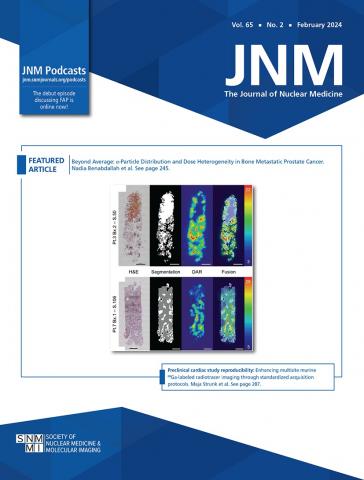在177Lu-PSMA放射配体治疗下psma阴性病变进展。
IF 9.1
1区 医学
Q1 RADIOLOGY, NUCLEAR MEDICINE & MEDICAL IMAGING
引用次数: 0
摘要
本文章由计算机程序翻译,如有差异,请以英文原文为准。
PSMA-Negative Lesion Progression Under 177Lu-PSMA Radioligand Therapy.
T his is the case of a 64-y-old man with metastatic castration-resistant prostate cancer treated with 5 cycles of 177 Lu-prostate-speci fi c membrane antigen (PSMA) radioligand therapy. After 2 cycles, prostate-speci fi c antigen levels declined from 26.1 to 15.2 ng/mL ( 2 42%) and interim PSMA PET/CT showed an overall favorable response with a decrease in whole-body PSMA tumor volume (1,430 cm 3 to 124 cm 3 , 2 91%) and no new lesions (Fig. 1A). Of note, a liver lesion with high baseline PSMA expression (SUV max , 28.0) showed a favorable response, with a decrease in size by CT (Fig. 1B), whereas PSMA-negative liver lesions (SUV max , 5.8) progressed, with signi fi cant increases in size (Fig. 1C). His prostate-speci fi c antigen level subsequently increased to 25 ng/mL after cycle 3, and he received 50 Gy delivered in 5 fractions of stereotactic body radiation therapy to the progressing liver lesions concomitantly with cycle 4, which led to a prostate-speci fi c antigen nadir of 10.9 ng/mL. Unfortunately, his prostate-speci fi c antigen level increased after cycle 5 (16.1 ng/mL) and the patient was switched to docetaxel and carbo-platin. His overall survival was 24 mo after baseline PET/CT. Low PSMA expression in prostate cancer cells can lead to low PSMA-targeted radiopharmaceutical uptake, insuf fi cient radiation dose delivery and subsequent growth of PSMA-negative
求助全文
通过发布文献求助,成功后即可免费获取论文全文。
去求助
来源期刊

Journal of Nuclear Medicine
医学-核医学
CiteScore
13.00
自引率
8.60%
发文量
340
审稿时长
1 months
期刊介绍:
The Journal of Nuclear Medicine (JNM), self-published by the Society of Nuclear Medicine and Molecular Imaging (SNMMI), provides readers worldwide with clinical and basic science investigations, continuing education articles, reviews, employment opportunities, and updates on practice and research. In the 2022 Journal Citation Reports (released in June 2023), JNM ranked sixth in impact among 203 medical journals worldwide in the radiology, nuclear medicine, and medical imaging category.
 求助内容:
求助内容: 应助结果提醒方式:
应助结果提醒方式:


